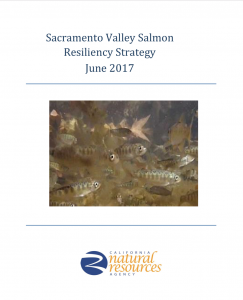In an August 21 blog post, Dr. Peter Moyle described recent Delta fish science and the future of San Joaquin River salmon. Dr. Moyle summarized five papers with relevance to the Central Valley. Below, I comment on the discussion on the San Joaquin smolt salmon tagging study.
The first bullet point in Dr. Moyle’s blog post reads: “Flows do not improve San Joaquin salmon survival but salvage does.” He then makes observations, shown below in italics.
- “The study nevertheless shows that juvenile Chinook from the San Joaquin region are not surviving passage through the south Delta and that increased flows are not likely to increase their survival.” Comment: It is generally true that juvenile San Joaquin Chinook are not surviving passage. However, the conclusion that increased flows are unlikely to increase survival is based on a series of six years with mostly low flows and one wet year, 2011, a year with record exports. There is no doubt that San Joaquin salmon do better in wetter years.1 The survival of the relatively small number of radio-tagged hatchery smolts in the cited study was low because south Delta exports minimize the ability of smolts to escape the San Joaquin side of the Delta. Most of the San Joaquin water (and salmon) goes to the export pumps. Once there, putting the smolts in a taxi to the Bay does obviously help them escape the Delta. Moyle fails to note that San Joaquin salmon are “ocean type”, meaning they move to the Delta often as fry or fingerlings, and rear in the Bay-Delta before moving to the ocean. These fry/fingerlings were not included in the study and most certainly benefit from higher winter flows.
- “Large-scale improvement of habitat in the south and central Delta is likely the key to improved survival, as shown by higher survival rates of fish from the Sacramento River that pass through the north Delta.” Comment: Yes, if he means flow-habitat improvements by eliminating south Delta exports and improving positive flows. Physical habitat improvements in the central and south Delta will not help without sufficient winter inflows to carry young salmon downstream to the Delta and to stop misdirected movement toward the export pumps if young salmon reach the Delta.
- “The basic results showed such low survival of salmon passing through the Delta that returning adults would be too few to sustain the salmon populations in the San Joaquin basin.” Comment: San Joaquin salmon do well in wet years. 1 Under current water operations in most years, river and Delta survival is low because most of the watershed’s water is diverted, held in reservoirs, or exported from the Delta.
- The study indicates that the lack of decent habitat for juvenile salmon in the Delta means that most are picked off by predators (as shown in part by tagged fish moving in the wrong direction because the tags are in the stomachs of predators). Comment: No, these were smolts, not smaller juveniles, and they were trying to find the ocean, not decent habitat. They had to spend too much time trying to find the escape route from the Delta. Eventually, they succumbed to a wide range of stressors.
- “Essentially, fall-run Chinook populations in the San Joaquin basin are being sustained by straying hatchery fish from the Sacramento River system.” Comment: All Central Valley salmon fall-run salmon populations are sustained directly or indirectly by hatcheries. The San Joaquin has its own hatcheries whose smolts also benefit from higher flows. 3 While gene flow among the populations has been high, it does not preclude individual populations from developing river/watershed-specific characteristics through natural selection.
- “How badly do we want to restore self-sustaining salmon runs to the San Joaquin and its tributaries? This question has to be asked in the context of future scenarios of climate change with increasingly variable conditions and likely permanent flooding of Delta islands.” Comment: Moyle seems to suggest that restoring “self-sustaining” San Joaquin runs may not be worth the effort. While “self-sustaining” may be very difficult to achieve for all Central Valley salmon populations given all the dams, loss of habitat, and water diversions, a balance of “wild” and hatchery salmon (and dependent fisheries) has been possible and will be so in the future if water resources are shared as required by federal and state laws.
- Salmon production is on average ten times better in wetter years. http://calsport.org/fisheriesblog/?p=1518 ↩
- Salmon production is on average ten times better in wetter years. http://calsport.org/fisheriesblog/?p=1518 ↩
- http://calsport.org/fisheriesblog/?p=1403 ↩















